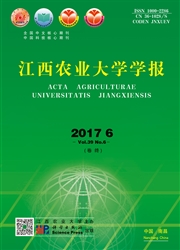

 中文摘要:
中文摘要:
在盆栽及温室条件下,对毛桃[Prunus persica(L.)Batsch]实生苗进行不同浓度盐(NaCl)胁迫处理,测定其叶片的光合作用、抗氧化防御体系及无机离子浓度,探讨毛桃在盐胁迫下的一些生理生化响应。结果表明,在盐胁迫下毛桃叶片光合速率、气孔导度、水分利用率下降,而蒸腾速率上升。随着NaCl浓度的升高,毛桃叶片过氧化氢和超氧阴离子自由基浓度明显升高,膜脂过氧化产物丙二醛含量增加,表明叶片受到伤害。酶防御系统中SOD快速响应,在盐胁迫后迅速升高;非酶防御系统中可溶性蛋白和还原性抗坏血酸受到盐胁迫的抑制。100mmol/LNaCl处理对叶片还原型谷胱甘肽的含量没有影响,但200mmol/L的NaCl处理则显著促进了还原型谷胱甘肽的含量。在盐胁迫下,毛桃叶片Na^+和Cl^-浓度升高;K^+、Mg^2+、Ca^2+受盐胁迫刺激后也升高;其他离子与Na^+的比值在盐胁迫下减小。
 英文摘要:
英文摘要:
The research was performed in a green house under potted conditions to evaluate the effects of salt stress on photosynthesis,antioxidant protective systems and inorganic ionic concentrations of Prunus persica (L.) Batsch seedlings,aiming for a better understanding of the physiological and biochemical responses to increasing salinity (NaCl).The results showed that photosynthetic rates,stomatal conductance,and water use efficiency in leaves were reduced by salt stress,but transpiration rates were increased.Hydrogen peroxide and superoxide radical concentrations increased with the salinity increasing.The phenomena was also observed in malondialdehyde,which suggested that the leaves of Prunus persica (L.) Batsch suffered from salt injure.SOD activities quickly responded and then increased when Prunus persica (L.) Batsch seedlings were subjected to salt stress.Soluble protein and reduced ascrobate contents in leaves were restrained by salt stress.When the seedlings were exposed to 100 mmol/L NaCl,reduced glutathione content was not affected,whereas salt stress stimulated the accumulation of reduced glutathione of the seedlings exposed to 200 mmol/L NaCl.Salt stress induced the accumulation of Na^+ and Cl^-,but reduced the concentrations of K^+,Ca^2+ and Mg^2+ and the ratio of other ions and Na^+.
 同期刊论文项目
同期刊论文项目
 同项目期刊论文
同项目期刊论文
 Spatial distribution of glomalin-related soil protein and its relationships with root mycorrhization
Spatial distribution of glomalin-related soil protein and its relationships with root mycorrhization Exogenous polyamines affect mycorrhizal development of Glomus mosseae-colonized citrus (Citrus tange
Exogenous polyamines affect mycorrhizal development of Glomus mosseae-colonized citrus (Citrus tange Alleviatin of salt stress in citrus seedlings inoculated with mycorrhiza: changes in leaf antioxidan
Alleviatin of salt stress in citrus seedlings inoculated with mycorrhiza: changes in leaf antioxidan Exogenous putrescine, not spermine or spermidine, enhances root mycorrhizal development and plant gr
Exogenous putrescine, not spermine or spermidine, enhances root mycorrhizal development and plant gr Root morphological modification of mycorrhizal citrus (Citrus tangerine) seedlings after application
Root morphological modification of mycorrhizal citrus (Citrus tangerine) seedlings after application Differences of hyphal and soil phosphatase activities in drought-stressed mycorrhizal trifoliate ora
Differences of hyphal and soil phosphatase activities in drought-stressed mycorrhizal trifoliate ora Arbuscular mycorrhizal fungi can alter some root characters and physiological status in trifoliate o
Arbuscular mycorrhizal fungi can alter some root characters and physiological status in trifoliate o 期刊信息
期刊信息
